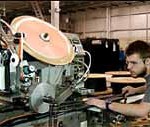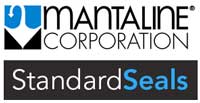In-line Processes
Cutting
Our automated in-line cutting machinery can be used on projects with extrudite cross-sections as large as 2 1/2-inch diameter and can produce cut lengths as short as two inches. This is, of course, dependent on the compound used, tolerances required, and other variables.
 Taping
Taping
Mantaline provides a wide range of pressure sensitive (PSA) and heat activated (HAT) tapes. To optimize costs, many of these tapes can be applied in-line: extrudite passes a primer station where primer is applied and dried then the tape is laid down on the passing product. In cases where the product base material is sponge rubber – which shrinks appreciably over the first seventy-two hours after it is produced – tape can be applied off-line.
In taping silicone products, we use our own primer (produced in-house) prior to applying pressure-sensitive tape to the silicone rubber base product.
Coating (Low Friction)
Our specialized coatings, applied in-line or off-line, help improve the functionality of an extrusion. The use of specialized coatings enhances the ‘freeze release’ capabilities of the extrusion; for example, car or truck door and window seals, which, in return, reduces friction or removes any tendencies for the extrusion to add to the noise and vibration characteristics of the product on which it is installed.
Printing
Printing part numbers and other important data directly on the part is a capability many customers want us to perform. This can be done in-line or off-line through a variety of techniques including paint printing, laser printing and bar-coding.
Drilling
Many seals require ‘vent holes’ which enable the seal to collapse when pressure is applied; for example, when a door closes. The extrusion process is such that we can add drilling to the extrusion as it is manufactured.
Autoclave Cure
Autoclaves are used to promote the curing process in off-line rubber extrusion. During the autoclave curing process, shapes created by forcing ‘warm rubber’ through an aperture or die, are exposed to high pressure steam, brought to the specific compound’s vulcanizing temperature and held there until the chemical reaction is complete.
This ‘batch process’ is ideal for creating shaped tubes: prior to the batch entering the autoclave for curing, each uncured tubular shape is forced over a mandrel and the rubber maintains the distinct shape imparted by the mandrel as it cures. This is very useful when making well-made radiator hoses, fuel tubes and other formed hoses.



